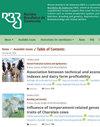描述考虑不同猪遗传和杂交猪营养计划的潜在变量
IF 1.2
4区 农林科学
Q3 Agricultural and Biological Sciences
Revista Brasileira De Zootecnia-Brazilian Journal of Animal Science
Pub Date : 2022-01-01
DOI:10.37496/rbz5120220021
引用次数: 0
摘要
-我们的目标是利用因子分析降低猪的数量性状的维度。收集定量变量,进行因子分析,提取与生产性能、胴体品质、胴体产量、肉品质和初始ph相关的5个具有生物学意义的因子,并将这些因子作为因变量,分别评价遗传群体(Piau、Duroc和Pietrain杂交品种)、营养计划(低、中、高赖氨酸水平)和性别的影响。在生产性能上存在遗传群与性别间的互作效应,其中杜洛克杂交种得分最高。Pietrain遗传组的胴体品质值高于杜洛克和Piau, Piau遗传组的肉质值高于Pietrain遗传组和杜洛克遗传组。与杜洛克猪相比,彼得兰杂交猪的胴体产量更高。低赖氨酸水平饲喂的猪生产性能值最低。胴体产量受营养计划的影响,其中中赖氨酸水平影响最大。与低赖氨酸水平相比,高赖氨酸水平的营养计划改善了肉质。当采用低赖氨酸和中赖氨酸水平的营养计划时,初始pH值增加。在性别效应方面,后备母猪的胴体质量高于后备母猪。数据维数的降低允许在基于因素生物学解释的更简单框架下,基于代表原始数据集的新潜在变量对遗传组、营养计划和性别进行联合评估。本文章由计算机程序翻译,如有差异,请以英文原文为准。
Depicting latent variables considering different pig genetics and nutritional plans in crossbred pigs
- We aimed to reduce the dimensionality of quantitative traits in pigs applying factor analysis. Quantitative variables were collected, and the factor analysis extracted five factors with biological meaning related to performance, carcass quality, carcass yield, meat quality, and initial pH. These factors were posteriorly used as dependent variable to evaluate the effects of genetic groups (Piau, Duroc, and Pietrain crossbreds), nutritional plans (low, medium and high lysine levels) and sex. An interaction effect between genetic group and sex was observed in performance, in which Duroc crossbred showed the greatest scores. The Pietrain genetic group showed greater values of carcass quality compared with Duroc and Piau, while Piau crossbred pigs had greater values for meat quality compared with Pietrain and Duroc. A greater carcass yield was observed in Pietrain crossbred compared with Duroc pigs. Pigs fed under low lysine level had the lowest performance values. Carcass yield was affected by nutritional plans, in which the medium lysine level showed the greatest values. Meat quality was improved by the nutritional plan with high lysine level compared with the low lysine level. Initial pH showed increased means when using nutritional plans with low and medium lysine levels in diet composition. With regard to sex effects, a greater carcass quality was found for gilts compared with barrows. The reduction of the data dimensionality allowed the joint evaluation of genetic group, nutritional plan, and sex based on new latent variables that represented the original dataset under easier framework based on factors’ biological interpretation.
求助全文
通过发布文献求助,成功后即可免费获取论文全文。
去求助
来源期刊
CiteScore
1.90
自引率
0.00%
发文量
25
审稿时长
8 weeks
期刊介绍:
The Revista Brasileira de Zootecnia (RBZ; Brazilian Journal of Animal Science) encompasses all fields of Animal Science Research. The RBZ publishes original scientific articles in the areas of Aquaculture, Biometeorology and Animal Welfare, Forage Crops and Grasslands, Animal and Forage Plants Breeding and Genetics, Animal Reproduction, Ruminant and Non-Ruminant Nutrition, and Animal Production Systems and Agribusiness.

 求助内容:
求助内容: 应助结果提醒方式:
应助结果提醒方式:


